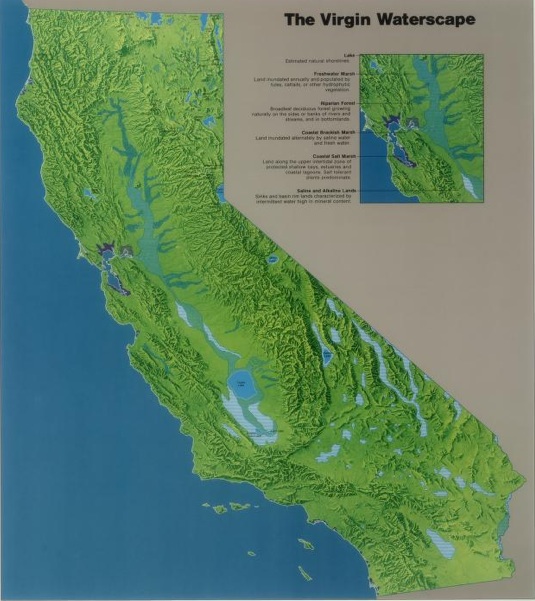Future Now
The IFTF Blog
The Future of Wild California
So far, most discussion stimulated by the Institute for the Future's Future of California research map and California Dreaming contest have focused on the future of human life in California, mostly ignoring non-human natives, and the largest most critical lifeform, the integral wilderness of California.
Early European visitors to wild California reported the central valley filled from horizon to horizon with herds of wild animals like a Serengeti in America. Somehow the dozens of distinct nations of aboriginal peoples lived in essential balance with the wild environment. Here's a map of the California landscape that existed prior to the great gold rush and migration in the 19th century:

Source: The California Water Atlas, 1979
Now, in less than 200 years European and other immigrant settlers have paved and otherwise developed vast parts of the natural environment of our state. Here's a recent map showing land use: (Note the black areas are mostly 'impervious surfaces' otherwise known as hardscape, pavement, buildings, and other manmade structures.)

Source: Jerimiah Easter www.californiaherps.com
One major impression from a map like this is that the black areas are completely dependent on consuming all of the resources, of the formerly healthy green and blue previously virgin landscape. So, in order to sustain human life in the future of California, humans have an explicit need to more carefully steward the natural non-human environment systematically as the source of all life in the state.
There are many citizen efforts and a few institutional efforts to nourish, and repair the natural environment of California so that our descendents in hundreds, if not thousands, of years in the future will still be able to appreciate the natural splendor and superior quaility of life in our state afforded by our vast natural resources.
Here's a map produced by California Department of Fish and Game researchers group showing planned (re)connections between critical habitats and wildlands:

Source: California Essential Habitat Connectivity Project
In his book of essays, "The Practice of the Wild" Here's how California's former Poet Laureate, Gary Snyder suggests we approach the task: "The original American environmental traditions came out of the politics of public lands and wildlife -game, fish, ducks - hence the nation is part of nature—our egos play in the field of the unconscious—history takes place in the Holocene—human culture is rooted in the primitive and the paleolithic—and our souls are out in the wilderness. "
Source: Gary Snyder, The Practice of the Wild, North Point Press; (September 1990)
___________________________________________________________
What will you do to help restore wild California for future generations? Share your thoughts in the California Dreams game and contest. (Contest ends nest week!) See prizes and details here.



